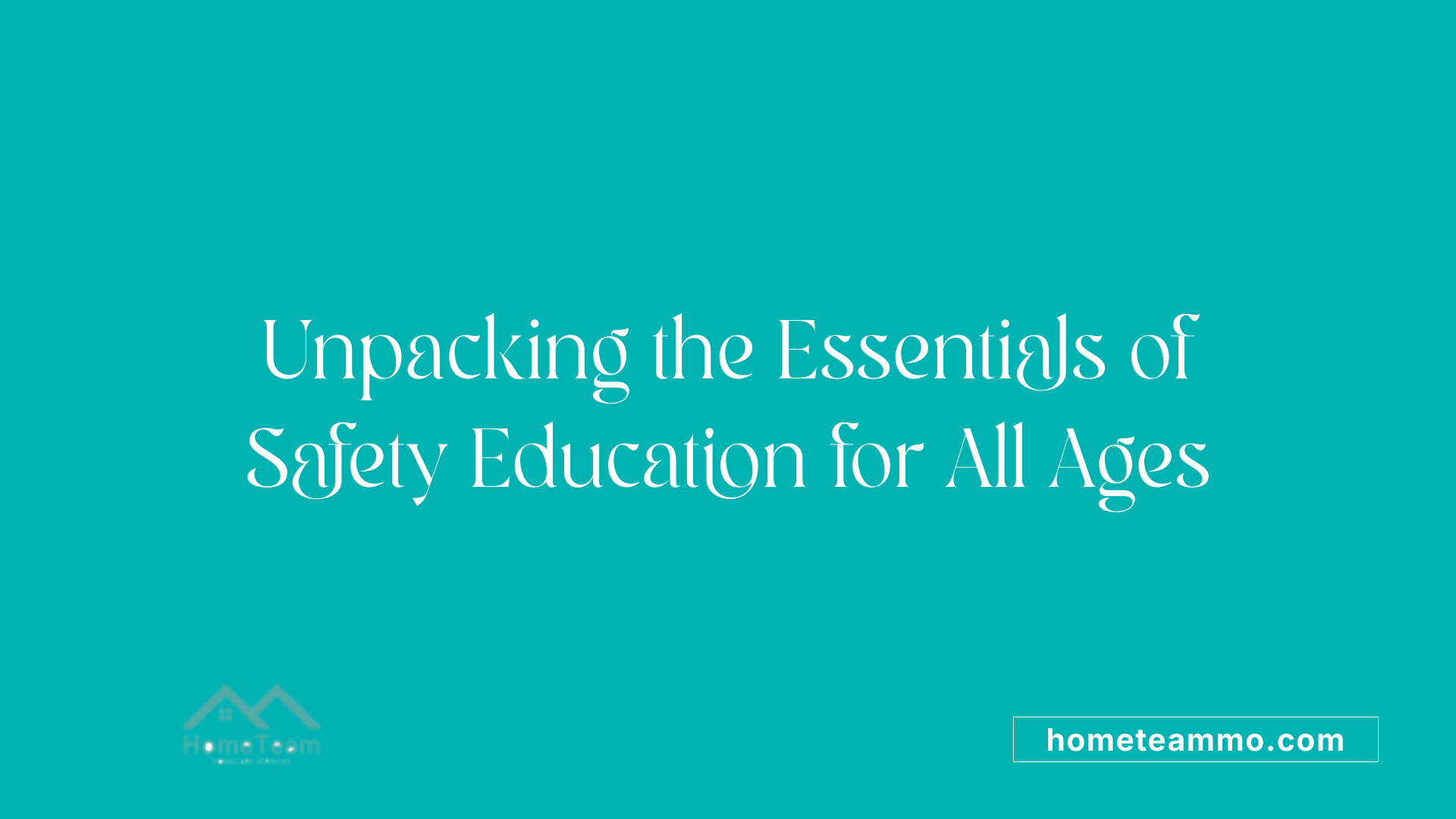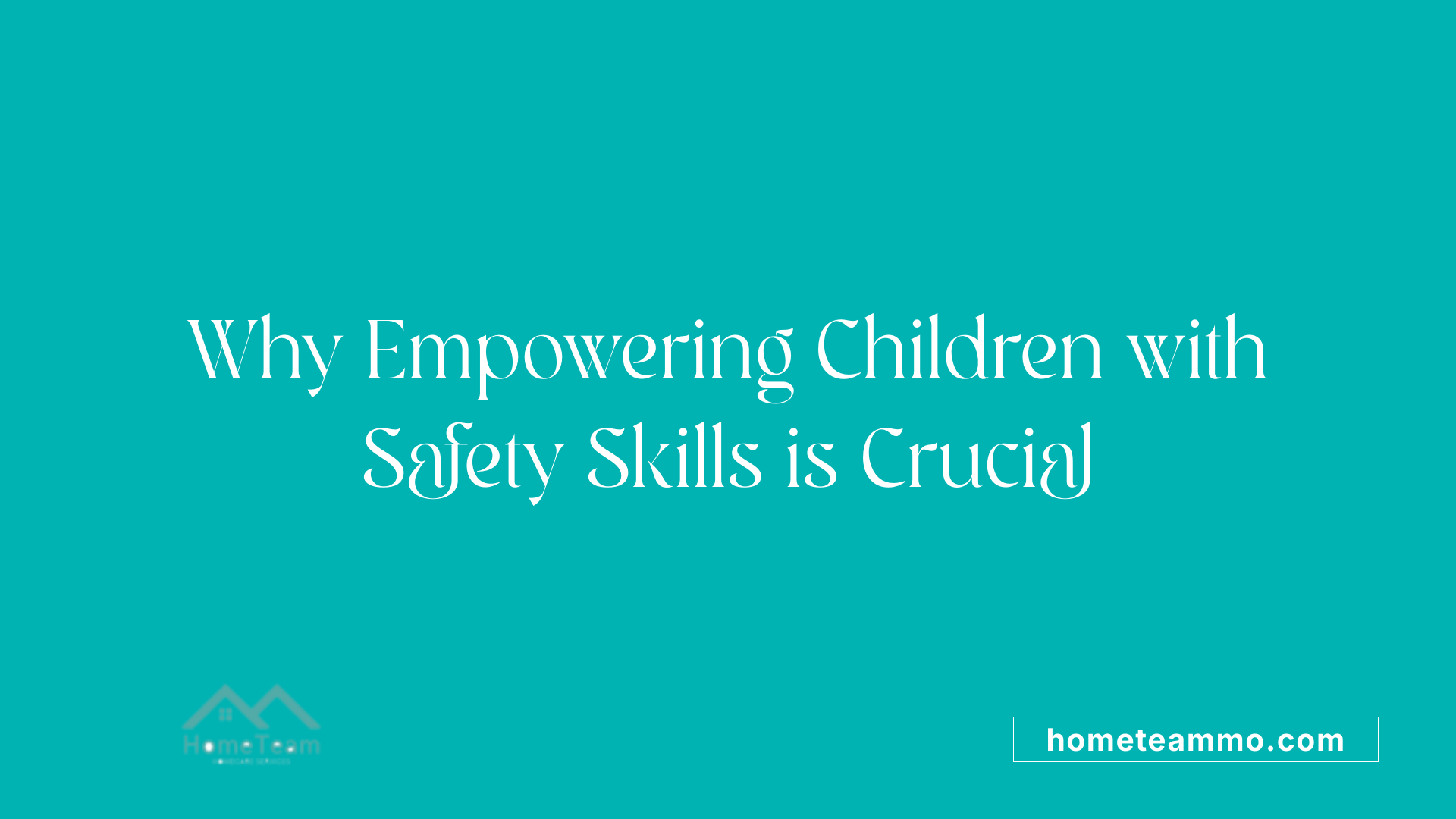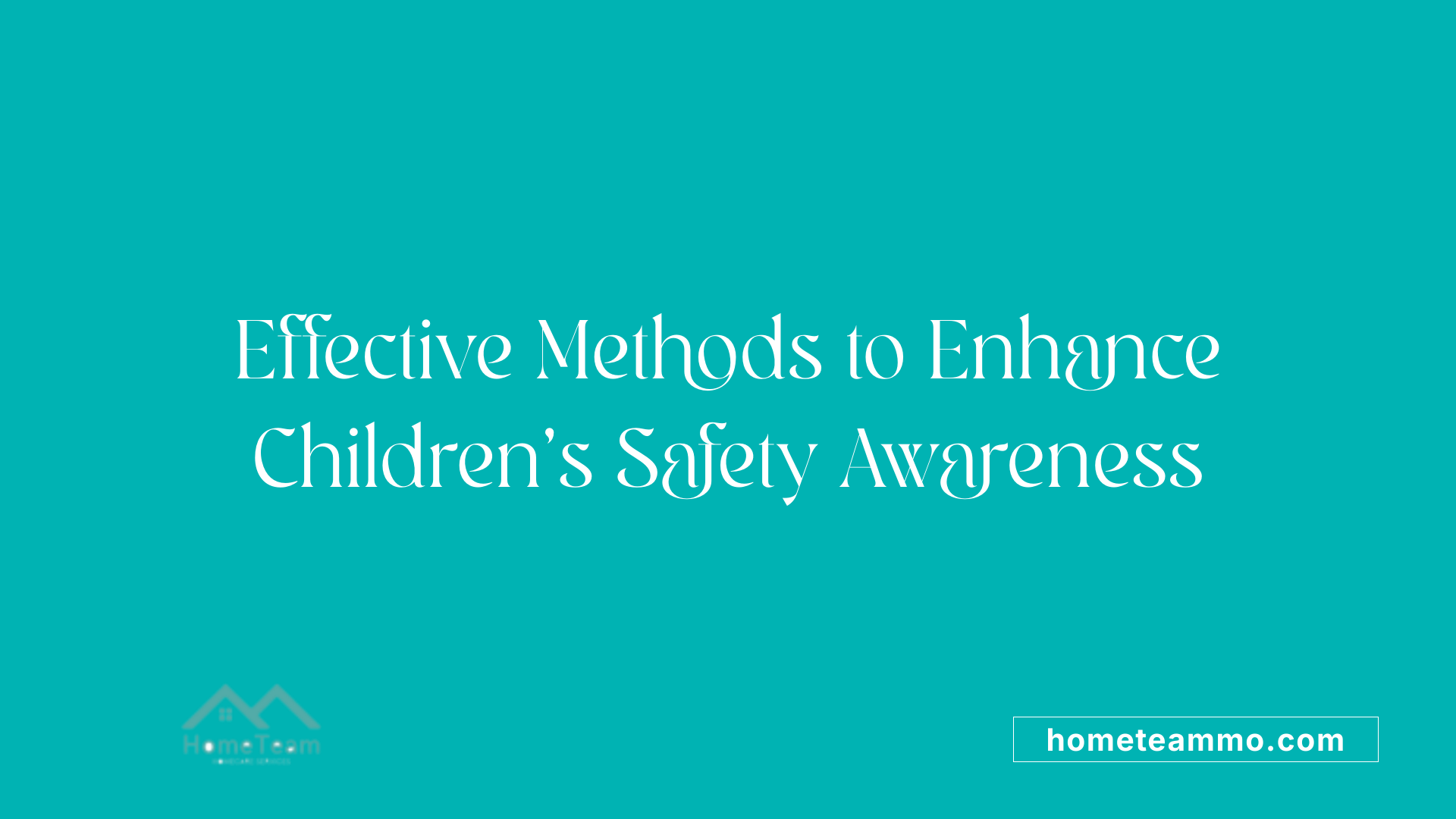The importance of teaching safety and awareness in public settings
Empowering Children Through Safety and Awareness Education

Introduction
Safety and awareness education in public settings have profound implications on children's adaptability, independence, and overall well-being. In an ever-evolving world, equipping young people with the necessary skills to navigate public spaces safely is both a parental and societal responsibility. This narrative explores various facets of teaching safety and awareness, highlighting the need for robust educational approaches, particularly in environments as dynamic as schools and public spaces.
Defining Safety Education

What is safety education?
Safety education is the process of teaching individuals, particularly children, essential life skills and social norms related to safety. Its primary aim is to protect children from potential hazards they may encounter in various environments. This education covers a wide range of topics, including:
- Road Safety: Understanding how to navigate streets, obey traffic signals, and recognize safe crossing points.
- Fire Safety: Learning about the dangers of fire, how to escape from a burning building, and ways to prevent fires.
- Personal Safety: Emphasizing the importance of recognizing unsafe situations and understanding rights related to personal safety, including the ability to say 'no' and seek help from trusted adults.
The engagement in safety education fosters a sense of responsibility and independence in children, empowering them to make safe choices in various situations. In workplace settings, it provides essential training for employees and managers to recognize hazards and implement safety protocols effectively.
Effective safety education also promotes long-term behavioral changes, leading to an overall enhanced safety culture, which is critical in schools and community settings alike. This foundation of knowledge prepares children to confidently participate in activities while minimizing risks.
The Necessity of Teaching Safety to Children

Importance of Safety Education for Children
Teaching safety to children is crucial for their empowerment and ability to recognize potential dangers. It ensures they know how to respond appropriately in risky situations. Open communication between parents and children fosters trust, allowing children to feel supported when they encounter uncomfortable or dangerous scenarios. For instance, discussing the concept of 'tricky people' and the importance of not keeping secrets from parents helps kids avoid manipulative situations.
Furthermore, instilling healthy tech habits from an early age prepares children for responsible device use and online interactions as they grow. In today's digital world, educating them about the risks associated with sharing personal information with strangers online is essential.
Development of Safety Skills and Awareness
Safety education also plays a pivotal role in developing essential safety skills and awareness among children. Learning about personal safety can reduce their likelihood of entering unsafe situations and enables them to respond appropriately when such situations arise.
Teaching children to distinguish between 'yes' and 'no' feelings empowers them to assertively say 'no' when something doesn’t feel right. Moreover, understanding body ownership and being comfortable to disclose uncomfortable experiences further fortifies their safety principles.
In summary, providing comprehensive safety education equips children with the necessary skills and confidence to navigate the world securely and independently, promoting a safer future for themselves.
Diverse Dimensions of Safety Education

What are the different types of safety education?
There are numerous avenues through which safety education can be delivered, each tailored to specific environments and audiences. The primary categories include:
Workplace Safety Training: Focuses on teaching employees how to identify hazards, adhere to emergency procedures, and grasp essential ergonomics. This type encompasses specialized topics like fire safety and electrical safety, aimed at fostering a safe workplace culture.
School Safety Programs: These are designed for both students and staff within educational settings. Key components include training on emergency protocols, implementing drills, and developing comprehensive emergency operations plans. Schools often focus on creating a culture of safety among students and staff through awareness campaigns and practical training.
Vocational Training Centers: Specialized programs in these centers offer hands-on training in various practical skills related to safety.
Organizations such as the American Red Cross: They provide lifesaving training in skills like CPR and First Aid. Such courses are designed for individuals who may find themselves in emergency situations, equipping them with critical response techniques.
Each type of safety education is crafted to meet the specific needs of its audience, ensuring that participants are well-prepared to manage risks effectively and confidently.
Building Safety Awareness: The Cornerstone of Protection

Why is awareness important in safety?
Awareness is crucial in safety because it enables individuals to identify and mitigate potential hazards, significantly reducing the risk of accidents and injuries. In various environments, from schools to workplaces, being aware of surroundings fosters a proactive attitude toward safety.
- Identifying Risks: An increased state of awareness allows individuals to perceive danger before it escalates into a serious situation.
- Enhancing Decision-Making: This competency supports better decision-making regarding safety protocols and procedures, ensuring quick reactions in emergencies.
- Reducing Work Disruptions: By focusing on safety awareness, organizations can minimize disruptions caused by accidents, which leads to heightened productivity and morale.
Impact of safety awareness
Creating a culture of safety awareness has profound effects, not just on individual safety but also on organizational success:
| Impact | Description | Example |
|---|---|---|
| Reduced Accidents | Better awareness leads to fewer accidents and incidents in the workplace. | Lower injury rates in safer workspaces. |
| Regulatory Compliance | Regular safety training ensures compliance with safety regulations. | Fewer fines from safety violations. |
| Enhanced Productivity | Minimizing accident-related downtime boosts overall productivity. | Employees can focus on tasks without interruptions. |
| Improved Employee Morale | A safe working environment fosters confidence and satisfaction among employees. | Increased employee retention due to a positive culture. |
Ultimately, a strong commitment to safety awareness creates a safer, more efficient work environment for everyone. Regularly updated safety messages and training further solidify this foundation, fostering a culture of continuous improvement.
Educators and Caregivers: Pillars of Safety Promotion
What role do educators and caregivers play in promoting safety?
Educators and caregivers are central to the promotion of safety among children. They provide essential education aimed at preparing children to effectively manage risks in various environments, especially as they grow more independent. Safety education is critical since accidents rank as one of the leading causes of severe injury and death among children.
By engaging children in discussions about identifying risks and understanding safety protocols, educators bolster compliance with safety rules. This not only empowers children to make informed decisions about hazards but also instills lifelong safety habits.
Additionally, safety education initiatives that incorporate community involvement are invaluable. For instance, tailored IEP (Individualized Education Program) goals can benefit students with disabilities by focusing on the development of skills needed to navigate public settings independently.
Hence, through structured safety education and active community engagement, both educators and caregivers significantly contribute to fostering a culture of safety, benefiting not just individual children but the community at large.
Community involvement in safety education
Community involvement plays a vital role in reinforcing safety education established by educators and caregivers. Collaborating with local safety officials, schools can develop relevant safety guidelines conditioned by real-life community contexts. This collaboration might include training sessions for both students and their families, emphasizing important safety skills applicable across various public environments.
Moreover, engaging families in safety education extends the lessons learned in the classroom to home environments. Initiatives that promote dialogue about safety between caregivers and children can enhance understanding and reinforce positive behaviors related to safety. Ultimately, the cooperative efforts of educators, caregivers, and the community create a well-rounded approach to safety education, ensuring that children feel secure and empowered to navigate the world around them.
Strategies for Teaching Safety Awareness

Methods to teach safety awareness to children
Teaching safety awareness is essential for helping children navigate their environments effectively. This can be achieved through various strategies that enhance their situational awareness. Begin by focusing on three critical components: perception, comprehension, and projection.
- Perception: Encourage children to actively observe their surroundings. Activities like nature walks, city explorations, or safety scavenger hunts can be effective. Ask them to identify changing elements in their environment, such as the presence of strangers or hazards.
- Mindfulness Techniques: Incorporate mindfulness exercises, like deep breathing and sensory activities, to sharpen children's focus on their immediate surroundings. This fosters greater awareness of their environment and reduces distractions.
- Role-Playing Scenarios: Use role-playing to help children apply their comprehension skills. By simulating potential safety situations (e.g., handling emergencies or dealing with strangers), they learn to analyze circumstances and anticipate outcomes.
Child safety skills development
As children build their safety awareness, they also develop vital skills that empower them to make safe decisions.
- Confidence Building: Promote open discussions about feelings of safety and trust. Encourage children to express when they feel uncomfortable and empower them to say 'no' if approached by strangers.
- Hands-On Learning: Teach through practical demonstrations, allowing kids to practice safe behaviors. For instance, using games that emphasize traffic safety or stranger danger scenarios can reinforce lessons in a fun way.
- Parental Involvement: Engaging families in safety discussions enhances consistency between home and school environments, further solidifying children's understanding of safety principles.
By implementing these strategies, children not only heighten their safety awareness but also cultivate a proactive mindset towards personal safety.
Inclusion and Special Needs: Prioritizing Equitable Safety Education
Safety Skills for Children with Special Needs
Children with special needs, such as those with autism spectrum disorder (ASD), face unique challenges in understanding safety concepts. This emphasizes the importance of tailored safety skills instruction to empower them in real-world scenarios. Programs should incorporate effective communication strategies, visual supports, and role-playing activities to enhance their ability to recognize and respond to safety threats.
Moreover, fostering independence through personalized safety plans can further support their safety awareness, ensuring that children feel more in control and able to express their needs during emergencies. Regular practice in realistic environments is essential for mastery, providing opportunities to rehearse safety responses in familiar settings.
Inclusive Safety Programs
Inclusion in safety education is vital for all students, particularly those with disabilities. Individualized Education Program (IEP) goals can address specific areas such as traffic safety, stranger interactions, and emergency preparedness, ensuring that every child develops essential safety skills.
Engaging families in safety education reinforces these skills at home, creating a cohesive approach to child safety. By collaborating with safety officials and utilizing community resources, inclusive safety programs can be developed that consider the diverse needs of all students, fostering a supportive and equitable learning environment.
Ultimately, ensuring that safety education is inclusive and tailored to the needs of children with special requirements not only promotes their independence but also enhances their ability to navigate public spaces confidently.
Community and Parental Involvement: Foundations of a Safety Culture
Importance of Community Involvement in Safety
Community involvement is essential for cultivating a culture of safety among children. Engaging local resources, such as first responders and community organizations, enhances safety education by providing real-world examples and hands-on experiences. This collaboration ensures tailored safety programs address specific community risks and empower children to navigate their environments confidently.
By fostering a community approach, schools can amplify safety awareness, leading to stronger support networks for children. When families and local entities work together, it helps establish high standards of safety that extend beyond the school environment, ensuring children are well-prepared for everyday situations.
Strategies to Engage Families in Safety Education
Engaging families in safety education can take many forms, including:
- Interactive Workshops: Hosting sessions where families learn safety protocols and practice emergency drills together.
- Resource Sharing: Providing families with safety toolkits, including guidelines on topics like stranger danger, online safety, and emergency preparedness.
- Regular Communication: Keeping families informed about safety initiatives and encouraging them to participate in school safety meetings.
- Home Safety Programs: Encouraging parents to discuss and reinforce safety practices, such as safe behaviors in public settings.
Through these strategies, children can develop a sense of shared responsibility for their safety, becoming more vigilant and proactive in avoiding hazards.
The Broader Impact of Safety Education: Academic and Beyond
Impact of safety education on academic performance
Safety education extends beyond ensuring the well-being of students; it plays a significant role in enhancing academic performance. Research indicates that a safe school environment correlated strongly with improved student engagement and academic success. Schools that prioritize safety not only witness increased attendance rates but also experience reduced truancy, allowing students to benefit more fully from educational opportunities.
Additionally, when students feel secure and valued, their ability to focus during lessons improves, fostering productivity in learning settings. A study by the Research Alliance for New York City Schools underscored that safety was a vital element influencing student academic improvement, highlighting the necessity of a nurturing environment.
Integration of safety with social-emotional learning
Integrating safety education with social-emotional learning (SEL) is crucial for developing well-rounded students. Safety awareness enhances skills such as empathy, decision-making, and personal rights understanding. Programs focused on social-emotional development can reduce behaviors like bullying by teaching conflict resolution and positive communication.
Moreover, SEL creates an inclusive atmosphere where students feel safe expressing themselves. This cultural shift towards safety and emotional awareness contributes significantly to creating positive learning environments. Engaging children in fun, interactive safety activities reinforces their understanding of safety hazards, while promoting their social skills and emotional well-being.
Incorporating safety education into the curriculum not only prepares students for real-world challenges but also lays the foundation for lifelong learning and resilience.
Understanding Safety Statistics and Program Outcomes
Research Findings on Safety Education
Safety education is crucial in reducing accidents and enhancing children's ability to navigate real-world threats. Research shows that when schools implement structured safety programs, students gain essential skills needed to identify hazards and react appropriately. These programs often incorporate active learning techniques, such as Behavioral Skills Training (BST) and in situ training (IST), preparing children for unsupervised situations. According to studies, children who rehearse safety responses under supervision demonstrate a marked improvement in self-reliance concerning hazard recognition, making them more confident in managing potentially dangerous scenarios.
Statistical Analysis of Accidents and Safety Outcomes
In the UK, accidents are a leading cause of injury and fatality among children. In 2012, 139 children under 15 lost their lives due to accidents, highlighting the urgency for comprehensive safety education. Government initiatives in England have recognized this need, integrating safety and risk education into the national curriculum. With a focus on evaluating IEP goals related to safety awareness, schools can systematically assess effectiveness and adapt strategies. Regular evaluations ensure that programs remain relevant, responsive to new safety challenges, and equipped to foster environments where children feel safe and confident.
Conclusion
Empowering children and communities through safety and awareness education is critical for fostering resilience, independence, and well-being. By involving educators, caregivers, and community members, we can create nurturing environments that prioritize safety, thereby laying a foundation for children and adults alike to navigate the complexities of public settings confidently and securely. As we invest in comprehensive safety programs and adapt educational practices, the collective effort will reinforce a culture of safety that permeates every aspect of public life.
References
- Why educate children and young people about safety and risk?
- Teaching Safety Skills to Children: A Discussion of Critical Features ...
- Developing Community Safety IEP Goals for Students with Disabilities
- Strategic Approaches to Safety Awareness IEP Goals for Special ...
- Promoting Safety Skills and Awareness in Children with Autism
- The Impact of Building a Culture of Safety in Schools - centegix
- Teaching Safety in the Classroom
- Public Awareness and OSHA Outreach Courses
- Stranger Danger: Teaching Kids the Importance of Safety

The benefits of community integration for individuals with autism

How to address food aversions and expand diet options

How to foster independence in children with autism through ABA therapy

The role of functional behavior assessments in developing effective treatment plans

How to navigate insurance coverage for ABA therapy services

The benefits of telehealth options for in-home ABA therapy

How to use token economy systems to encourage positive behavior

How to address bullying concerns with children with autism

How to support siblings of children with autism in the home

How to choose the right in-home ABA therapy provider

The role of humor and playfulness in building trust during therapy
.jpg)
When Will I Receive My Ebt Card After Being Approved?
.jpg)
What Old People Do for Fun?
.jpg)
Top 3 Benefits of CDPAP Caregiver Requirements
.jpg)
How Much Does a CDPAP Get Paid?
.jpg)
Services Offered by Special Needs Care Providers
.jpg)
What Are Retirement Statistics?
.jpg)
A Complete Guide To Home Care St. Louis

Forgetfulness vs Dementia

How long will Medicaid Pay for Home Care?
.jpg)
What Is Poverty Level Income For A One Person?
.jpg)
Top 3 Nutrition Tips for Seniors in Home Care
.jpg)
3 Types of Insurance Coverage for Home Care
.jpg)
How To Live Longer As A Senior?
.jpg)
How to Become a Home Care Provider for a Family Member?
.jpg)
What States Pay Family Caregivers?
.jpg)
How to Get Handicap Placard in NY?
.jpg)
Home Care Vs Assisted Living

The Most Common Home Care Covered by Insurance
.jpg)
What Are The Highest Paying Home Care Agencies?

CDPAP vs Home Care
.jpg)
Free Home Repairs for Senior Citizens

How to address challenges related to puberty and adolescence

Strategies for teaching self-regulation skills to children

The role of therapy in teaching financial literacy skills

The importance of teaching children with autism to handle disappointment

How to use social media as a resource for autism support

The role of social stories in teaching new skills

The importance of understanding co-occurring conditions in autism

The benefits of combining therapy techniques for holistic development

How to create effective reinforcement systems at home

The role of ABA therapy in developing emotional intelligence

How to handle regression in learned skills at home

How to manage sibling dynamics in families with a child with autism

How to promote self-care for parents of children with autism

The Role of Technology in Enhancing In-Home Care Services

The Role of Advocacy in Navigating the CDS System

Why In-Home Care is More Affordable Than Many Families Realize

How Home Team's Caregivers Provide Comprehensive Support

How CDS Programs Empower Individuals to Lead Independent Lives

How to Maximize the Benefits of CDS for You and Your Family

Why In-Home Care is the Best Choice for Individuals with Dementia

How to Build a Strong Relationship with Your In-Home Caregiver

Why In-Home Care is Ideal for Individuals Recovering from Surgery

How to Access Consumer Directed Services Without Hassle

The Role of Light Housekeeping in Creating a Healthy Home Environment

How to Find the Right Balance Between Independence and Support

What to Expect When Enrolling in a Consumer Directed Services Program

How to Avoid Caregiver Burnout with the Right Support

How to Create a Safe and Comfortable Space for Caregiving Activities

Why In-Home Care Services are the Best Option for Aging in Place

How to Choose the Right Caregiver for Your In-Home Care Needs

Why Home Team's Services Are Highly Recommended by Families

How to Ensure a Smooth Start to Your In-Home Care Journey

The Role of Personalization in Achieving Positive Care Outcomes

How to Manage Medications Effectively with the Help of In-Home Care

The Importance of Personalized Care Plans in Consumer Directed Services

The Benefits of Hiring a Trusted Agency for In-Home Care Services

Why Companion Care is Key to Combatting Loneliness Among Seniors

Why CDS Programs Are Ideal for Individuals with Long-Term Care Needs

Why Personal Care Services Are Essential for Aging in Place

How to Build a Successful Partnership with Your Caregiver

How CDS Programs Promote Dignity and Independence

How Home Team Helps Clients Access the Care They Need Most

The Role of Training and Support for Family Caregivers in CDS

How CDS Programs Reduce Stress for Families and Clients

The Importance of Open Communication in the Caregiving Process

How Home Team Ensures the Highest Standards in In-Home Care

The Importance of Reliable Caregivers in Maintaining Independence

Understanding the Role of Caregivers in the CDS Program

The Benefits of Physical Assistance for Individuals with Limited Mobility

How to Handle the Challenges of Caregiving with Support from Home Team

Why In-Home Care is a Safer Alternative to Assisted Living Facilities

How to Enhance Your Quality of Life with In-Home Care Services

The Importance of Regular Exercise for Nursing Home Residents

The Benefits of Physical Therapy for Nursing Home Residents

The Importance of Routine Vaccinations for Nursing Home Residents

How to Address Mental Health Issues in Nursing Home Residents

How to Support Residents with Chronic Illnesses in Nursing Homes

How to Develop a Health Promotion Program in Nursing Homes

How to Implement a Rehabilitation Program in Nursing Homes

How to Implement a Fall Prevention Strategy in Nursing Homes

How to Develop a Rehabilitation Strategy in Nursing Homes

How to Develop a Chronic Disease Management Strategy in Nursing Homes

How to Develop a Health Promotion Strategy in Nursing Homes

How to Support Residents with Vision Impairments in Nursing Homes




